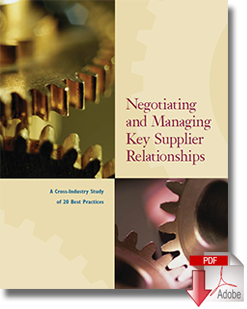20 Best Practices for Negotiating and Managing Key Supplier Relationships

As senior management places greater emphasis on sourcing and procurement as a means to gain competitive advantage, procurement is moving from the back office to the boardroom.
To achieve greater profitability, many more companies are partnering with their suppliers, borrowing elements of the Japanese keiretsu model which emphasizes integration, long-term relationships, and joint gain.
Companies have long expended considerable resource on sourcing and procurement.
As businesses continually hone their own core competencies and partner with other organizations to deliver value, even greater resource is spent on incoming goods and services.
Many companies now outsource even critical functions, as these arrangements hold out the promise of greater flexibility and innovation than could be achieved internally.
By many accounts, purchasing amounts to the second largest expense for many companies today, next to payroll.
According to some estimates, many manufacturing companies spend up to 70% of sales revenue on procurement.
Procurement to Gain Strategic Advantage
Traditionally, given the considerable amount of resource expended on procurement, purchasing has focused on saving money. Particularly in a weak economy, many companies have attempted to wring out cost savings by rationalizing their supply base and concentrating volume to gain price leverage.
Recently, however, companies have begun to view procurement more strategically, as a means to gain competitive advantage. The next sustainable wave of cost savings is being achieved through more sophisticated means by partnering with suppliers to jointly identify and realize new efficiencies.
In addition to driving out cost, companies are also increasingly working with their suppliers to spur innovation. Indeed, an ever more common motivation for outsourcing is to gain access to cutting edge practices.
“Economic forces and technological advances have combined over the past 20 years to increase the impact of procurement/supply management on company profitability and long-term business success. Procurement is now in a position to affect company profitability faster and more dramatically than any other corporate function”
Kevin Fitzgerald
20 Best Practices for Negotiating and Managing Key Supplier Relationships
Evaluation and Selection
1. Supplier assessment is a two-way activity
Focus is not only on evaluating the ability of a supplier to deliver, but also on jointly exploring possible challenges of working together and soliciting supplier input on what the customer could do to ensure a successful partnership.
2. Supplier selection is based on multiple factors
Suppliers are evaluated and selected not only on the basis of price, but also on indicators of their ability to work as collaborative partners.
3. A database captures current and potential supplier profiles
Detailed supplier profiles are used to inform the evaluation and selection process. In particular, information about past performance and interactions with a supplier is logged by those who have worked regularly with that supplier.
4. Protocols clarify how business unit customers and corporate sourcing should interact during supplier selection and negotiations
Guidelines are clearly defined for who is responsible for doing what, who has the authority to make which decisions, and who needs to be consulted for their input on which issues and decisions.
Negotiation
5. Supplier negotiations are managed as a collaborative process
Focus is on maximizing value for both sides, while coercive tactics aimed at “squeezing the last dollar” out of suppliers are avoided.
6. Negotiation is used as an opportunity to build a strong foundation for a good working relationship
Focus is as much on setting the stage for working together effectively once a deal is signed as it is on arriving at specific contract terms.
7. Negotiators are assessed and compensated based on overall quality of the deal
Assessments and incentives are based on multiple dimensions beyond price, including, for example, total value created, positive or negative impact on the relationship, value created for the supplier, and the like.
8. Formal transition activities are conducted when new supplier relationships are established
Such events involve anticipating and jointly planning for challenges, agreeing on decision making and escalation procedures for when disagreement or conflict arises, and jointly defining shared performance and relationship health metrics. Transition and joint launch events may also occur when major new contracts are signed.
Post-Deal Relationship Management
9. Relationships with suppliers who work with multiple business units are managed in a coordinated fashion
Communication and decision-making procedures are developed and implemented to ensure effective internal and external coordination.
10. Suppliers are encouraged to share innovations
A mechanism exists to enable suppliers to suggest product or process innovations and provides incentives for doing so.
11. A relationship manager is dedicated to each strategic supplier relationship
Dedicated relationship managers act as internal advocates for suppliers, serve as a resource and escalation point for suppliers, and facilitate coordination among different internal groups who interact with a given supplier.
12. A formal mechanism enables joint strategic planning with suppliers
Such a mechanism enables companies and their key suppliers to share information about their respective strategies, find ways to help each other meet important goals, and better align long term plans.
13. Enterprise sourcing strategy is aimed at creating and preserving long-term relationships with suppliers
Such a focus ensures companies maximize the value of supplier relationships where a long term time horizon is critical to facilitating joint planning and joint investment.
Performance Monitoring
14. Regular supplier relationship assessments are conducted
Assessments are conducted against metrics for business performance and the health and quality of the working relationship.
15. Relationship assessments are two-way
Focus is not only on supplier performance, but also on assessing whether the customer has met their obligations and on diagnosing problems jointly and finding opportunities for mutual gain.
16. Assessment data is reviewed and analyzed systematically and jointly with suppliers
A formal mechanism exists to ensure that problems or opportunities uncovered by assessments are acted upon.
Termination
17. Termination based on changes in strategy or business needs occurs in a way that minimizes negative impact
Such termination decisions are made in consultation with suppliers, with significant advance warning, and with efforts to mitigate impact to both parties.
18. Termination decisions are negotiated and communicated in a respectful, collaborative manner
Termination of supplier relationships is conducted in a way that preserves the potential for the parties to work together in the future, and minimizes potential for damage to a company’s reputation.
Portfolio Governance and Management
19. Supplier relationships are segmented into relevant tiers
Tiers are based on clearly defined criteria such as strategic importance and the cost of switching suppliers. A mechanism is created to help determine which tier suppliers fall into and how suppliers should be managed, depending on tier.
20. Complex supplier relationships are managed within a well-defined, formal governance structure
A governance structure, supported by relationship management processes, exists to manage relationships with key suppliers who are also customers and/or channels, and/or alliance partners.
Related: Why Emotional Intelligence Matters in Negotiations

Article Topics
Vantage Partners News & Resources
Samsung Asks Its Employees to Question Their Work Best Practices for Negotiating with Key Suppliers How Organizations Can Reinvent Procurement How Pratt & Whitney Is Managing Its Future Growth and Supply Chain Suppliers 20 Best Practices for Negotiating and Managing Key Supplier Relationships Why Emotional Intelligence Matters in Negotiations Negotiating & Managing Key Supplier Relationships More Vantage PartnersLatest in Supply Chain
How Supply Chains Are Solving Severe Workplace Shortages SAP Unveils New AI-Driven Supply Chain Innovations How Much Extra Will Consumers Pay for Sustainable Packaging? FedEx Announces Plans to Shut Down Four Facilities U.S. Manufacturing is Growing but Employment Not Keeping Pace The Two Most Important Factors in Last-Mile Delivery Most Companies Unprepared For Supply Chain Emergency More Supply Chain














